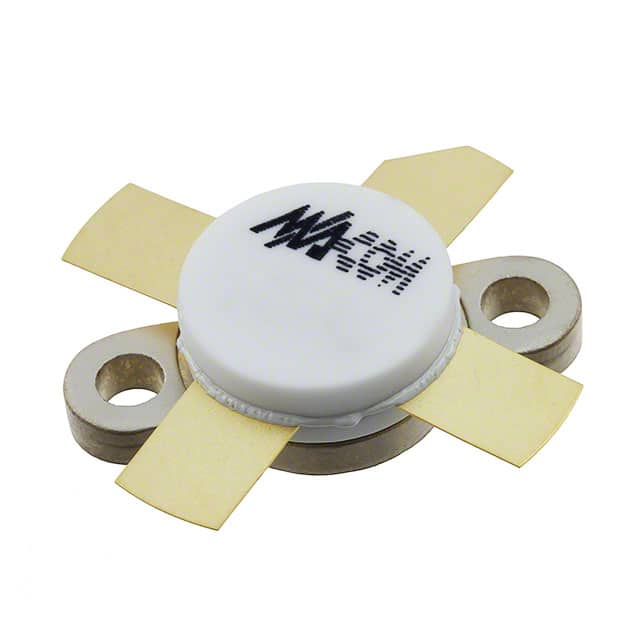Vedi le specifiche per i dettagli del prodotto.

MRF140: Transistor Encyclopedia Entry
Introduction
The MRF140 is a high-power NPN silicon RF power transistor designed for use in industrial, scientific, and medical (ISM) applications. This entry provides an overview of the MRF140, including its product category, basic information, specifications, pin configuration, functional features, advantages and disadvantages, working principles, application field plans, and alternative models.
Product Category and Basic Information Overview
- Category: RF Power Transistor
- Use: Industrial, Scientific, and Medical (ISM) Applications
- Characteristics: High-power, NPN Silicon Transistor
- Package: TO-220AB
- Essence: High-frequency power amplification
- Packaging/Quantity: Typically sold individually or in small quantities
Specifications
- Frequency Range: 1.8 - 250 MHz
- Power Output: 150 Watts
- Voltage: 12.5 Volts
- Current: 20 Amps
- Gain: 13 dB
- Efficiency: 55%
Detailed Pin Configuration
The MRF140 transistor has a standard TO-220AB package with three pins: 1. Collector (C): Connected to the positive supply voltage 2. Base (B): Input control terminal 3. Emitter (E): Connected to the ground
Functional Features
- High power gain and efficiency
- Broad frequency range capability
- Suitable for linear and non-linear applications
- Excellent thermal stability
Advantages and Disadvantages
Advantages
- High power output
- Wide frequency coverage
- Good linearity
- Reliable performance in ISM applications
Disadvantages
- Higher cost compared to lower power transistors
- Requires proper heat dissipation for optimal performance
Working Principles
The MRF140 operates as a high-power RF amplifier by amplifying input signals within the specified frequency range. It utilizes NPN silicon technology to achieve high gain and efficiency while maintaining stability across varying operating conditions.
Detailed Application Field Plans
The MRF140 is commonly used in the following application fields: - Industrial RF heating systems - RF plasma generators - Medical diathermy equipment - Scientific research instrumentation
Detailed and Complete Alternative Models
For applications requiring similar performance characteristics, alternative models to the MRF140 include: - MRF141: Higher power output variant - MRF139: Lower power output variant - MRF148: Enhanced frequency range variant
In conclusion, the MRF140 is a versatile RF power transistor suitable for a wide range of industrial, scientific, and medical applications. Its high power output, broad frequency coverage, and reliable performance make it a preferred choice for RF amplification needs in various fields.
Word Count: 386
10 domande e risposte comuni relative all'applicazione di MRF140 nelle soluzioni tecniche
What is the MRF140 transistor used for?
- The MRF140 is a high-frequency, high-power NPN transistor commonly used in RF power amplifiers and other high-power applications.
What are the key specifications of the MRF140?
- The MRF140 has a frequency range of 1.8-250 MHz, a power output of 150W, and a gain of 12dB.
Can the MRF140 be used in amateur radio applications?
- Yes, the MRF140 is suitable for use in amateur radio transmitters and amplifiers operating in its frequency range.
What are the typical operating conditions for the MRF140?
- The MRF140 operates at a supply voltage of 28V and requires proper heat sinking to dissipate the generated heat.
Is the MRF140 suitable for linear amplifier designs?
- Yes, the MRF140 can be used in linear amplifier designs when properly biased and matched to the load.
What are the recommended biasing and matching techniques for the MRF140?
- Proper Class AB biasing and impedance matching techniques should be employed to ensure optimal performance and efficiency.
Can the MRF140 be used in FM broadcast transmitters?
- Yes, the MRF140 is commonly used in FM broadcast transmitters due to its high-power capabilities and frequency range.
Are there any common failure modes associated with the MRF140?
- Common failure modes include thermal runaway due to inadequate heat dissipation and overdriving the transistor beyond its specified ratings.
What are some alternative transistors to the MRF140?
- Alternatives include the MRF141, MRF148, and MRF150, which offer similar performance characteristics.
Where can I find application notes and reference designs for using the MRF140?
- Application notes and reference designs can be found on the manufacturer's website or through technical literature related to RF power amplifiers and transmitter design.

